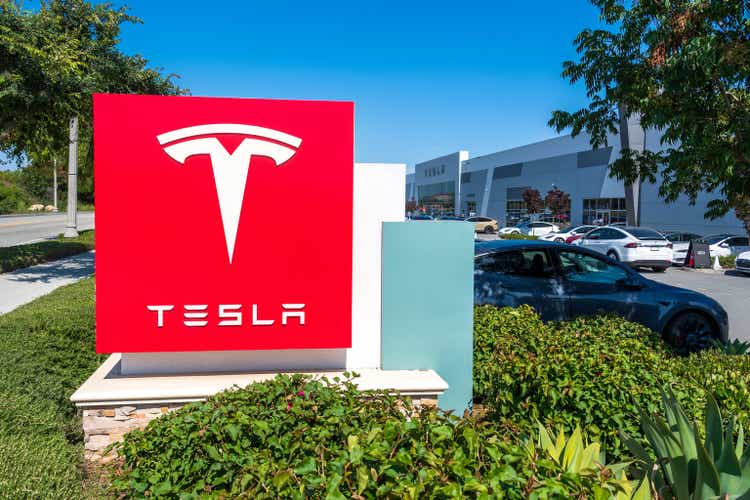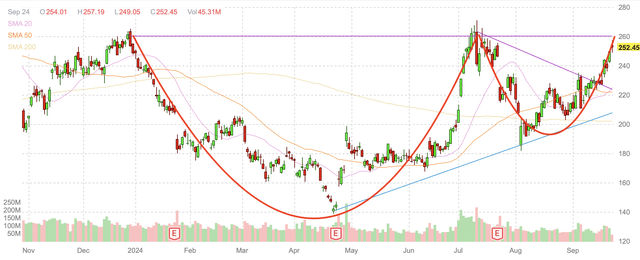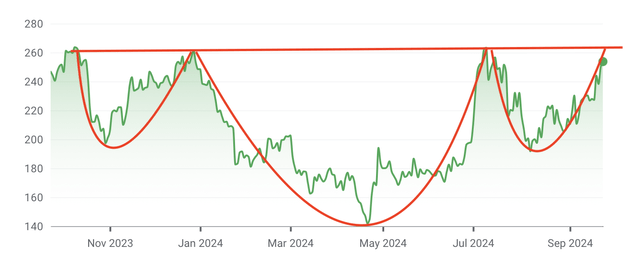Summary:
- Tesla is breaking out of a summer trading range, with shares approaching a critical $260 resistance level that could signal a move to $300.
- Tesla’s operational advantages, including its EV production capacity and FSD technology, position it well against domestic and international competitors.
- Revenue growth is expected to accelerate in 2025 and 2026, driven by new factories and potential Cybertruck deliveries, despite low single-digit growth in 2024.
- Risks include competitive pressures and potential secondary offerings, but Tesla’s history of exceeding expectations and multiple growth avenues offer significant upside.
baileystock
Tesla, Inc. (NASDAQ:TSLA) is breaking out of a trading range that kept the company’s shares range-bound for most of the summer. In early September, when shares were around $210, I proposed that TSLA appeared ready to break out. Moreover, I noted that if shares could get through the $220s, I believed they would be primed to gap up and break-out to considerably higher levels. This thesis has thus far played out, and I believe that Tesla has the potential to continue its move through the $200s.
Tesla shares are once again approaching an inflection point where shares have a strong likelihood to either reverse course or break higher. Much as was the case when Tesla moved through the $220s, only to subsequently accelerate upwards, the $250s represent a similar level of prior support and resistance. Further, if shares can push above $260, it will be a clear breakout of this range and the completion of a cup & handle pattern that has been forming since the start of the year.
TSLA daily candlestick chart (Finviz.com with red lines by Zvi Bar)
As the above chart shows, $260 has been resistance and a high mark for TSLA shares since the start of the year. Tesla made a strong move towards breaking out of this resistance in July only to fail and fall below $200. Now, they are again approaching this level, and it seems exceedingly likely that they will either quickly reverse or a continue to move higher.
Further, this is not only a cup and handle, but also an inverse head and shoulders pattern, as you can see there is another similar peak and trough to the left of the cup. That inverse H&S pattern has a neckline resistance pivot range at about $260 as well.
TSLA 1 year chart with inverse Head & Shoulders pattern (Google Finance with red lines by Zvi Bar)
Tesla remains the domestic market leader in electric vehicles (???EVs???) and appears likely to maintain this position for a while. Tesla also appears capable of competing within most international markets. Tesla opened two factories in 2022 that will allow it to ramp up its production capacity, as well as achieve continued operational advantages while most of its domestic competitors cannot yet profitably manufacture EVs at scale.
Tesla’s business model includes selling electric vehicles EVs and servicing auto-related costs incurred by its customers, including insurance, batteries & charging systems, and autonomous driving software subscriptions. Tesla’s business also includes solar panels and energy storage batteries that can service residential and commercial uses. The company’s competence within power generation and storage in markets outside of automotive has the potential for considerable growth in the coming years.
Tesla’s operational advantages versus most of its domestic EV competitors are considerable. No other domestic manufacturer is yet capable of producing a competitive threat at scale, let alone at a profit. While its competitors are trying to develop the capacity to build EVs at scale and with a profit margin, Tesla is consistently reducing its unit production costs, and often reducing the retail price of its vehicles.
Tesla also has the potential to benefit from full self-driving (???FSD???) software. Tesla already sells its existing FSD service as a monthly subscription, and it is probable that Tesla’s subscription revenue will substantially increase as the technology improves. It is also possible that some competing auto manufacturers could eventually license Tesla’s FSD technology, much like how several have adopted Tesla’s Superchargers. Similarly, Tesla is at a tremendous advantage versus its peers at manufacturing its own batteries and the software that utilizes and charges them. It could end up being the case that competing auto manufacturers either acquire their batteries from Tesla, or license its technology in order to more efficiently use their batteries.
Tesla’s revenue is expected to increase in the low single digits in 2024, which is low for the company. Tesla’s recent development of factories in Austin, Texas and Berlin, Germany, should significantly increase the company’s global production capacity over the next two years. As a result, Tesla’s revenue should once again accelerate in 2025 and 2026, even if some of its prices are cut. I believe its revenue could go up between 10-20% in each of the next two years. While the precise level of revenue growth will be dependent upon not only production capacity and whether Tesla reduces its pricing, but also the competitive landscape. Another unclear factor is whether Tesla will release a new model.
Tesla’s Cybertruck is another unclear factor, as Tesla has been slow to manufacture and deliver them. At the same time, the Cybertruck has a reservation count of over two million units. If Tesla is able to service these reservations and deliver a growing number of units in the coming months and quarters, the Cybertruck should become a highly meaningful producer of revenue in 2025 and 2026.
I continue to expect Tesla to have adjusted earnings per share of about $2.40 in 2024, and for it to realize EPS of $3.50 or greater in 2025. Tesla also has a balance sheet commensurate with a mega-cap tech company, with a cash position of over $30 billion, and virtually no debt. If Tesla can increase its cash position over the next year, it may be in a position to initiate a share repurchase plan.
While Tesla is by no means an undervalued equity, the company has a history of growing its business beyond expectations. Further, Tesla’s business includes multiple moonshots, such as AI computing and the development of humanoid robots for the market. These nascent businesses may end up being even larger than automotive, though probably not in the near term. Similarly, Tesla’s position in FSD may develop the capacity for a ride-hailing application that could either compete with existing systems, or be utilized by them.
Furthermore, Tesla’s battery technology may not just become a product for competing auto manufacturers, but also become adopted for use within the electric utility marketplace. Electric utilities are experiencing growing capacity demands that could benefit from deployable storage systems. Tesla’s solar power panels may also experience growth if the cost of electricity were to considerably increase.
Risks
Tesla has been an opportunistic issuer of secondaries to raise capital. While it has not recently issued a secondary offering, the company may opt to do so to fund its development plans. The probability of a secondary increases along with share price appreciation.
Risks to Tesla include competitive pressure from traditional automakers, as well as new competition from Chinese manufacturers. Competitors are making significant investments in developing their EV manufacturing capacity. This competition could take some market share. There is also the potential for competitors to place pricing pressure on existing EVs, thereby reducing margins. This could result in lower-than-expected revenue and earnings estimates.
Domestic competition from Chinese EV makers is likely to be at least partially stifled by political maneuvering, including potential tariffs and subsidy exclusions. Tesla could also face pricing competition in the form of lost subsidies, and this could depend upon where certain a model’s batteries are made. For example, Tesla’s Model 3 contains a Chinese battery that would likely disqualify it from eligibility for U.S. subsidies.
Conclusion
Tesla has always been prone to rapid repricing following a change in momentum. Tesla underperformed in the first half of 2024, and were range bound throughout the summer, but shares have been doing exceptionally well in September. I continue to believe that Tesla is going through a breakout cycle that is likely to continue through the end of 2024. Tesla shares have gained roughly 20% in the last three weeks and are now approaching a test of their 2024 highs, at around $260.
If Tesla can break through that level, this would also complete both a cup & handle chart pattern that has been building since the start of the year, and an inverse head and shoulders pattern that has been forming for a full year. On a breakout of these patterns and pivot points, and a strong move through the low $260s, Tesla appears capable of gapping up to around $300 next quarter, and possibly within the next month. At the same time, if Tesla bounces off of the $260 level and quickly falls even a few percent, that would likely indicate this recent move has run its course and that shares lack sufficient conviction to continue this existing move higher. In such an instance, I would lose conviction in a continuing move higher in the near term, and wait for shares to prove they can move through the $260s before adding exposure.
Analyst???s Disclosure: I/we have a beneficial long position in the shares of TSLA either through stock ownership, options, or other derivatives. I wrote this article myself, and it expresses my own opinions. I am not receiving compensation for it (other than from Seeking Alpha). I have no business relationship with any company whose stock is mentioned in this article.
Seeking Alpha’s Disclosure: Past performance is no guarantee of future results. No recommendation or advice is being given as to whether any investment is suitable for a particular investor. Any views or opinions expressed above may not reflect those of Seeking Alpha as a whole. Seeking Alpha is not a licensed securities dealer, broker or US investment adviser or investment bank. Our analysts are third party authors that include both professional investors and individual investors who may not be licensed or certified by any institute or regulatory body.
